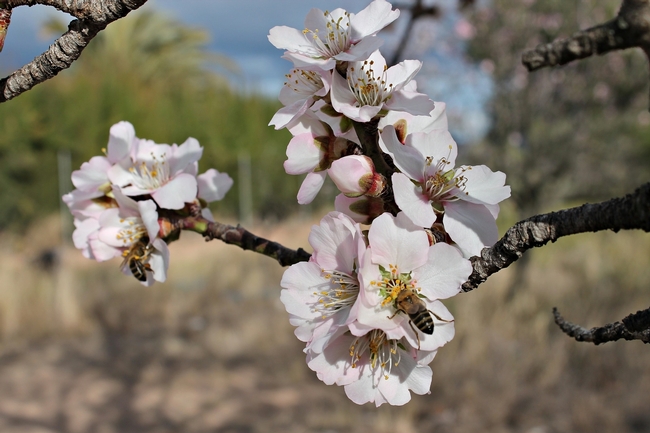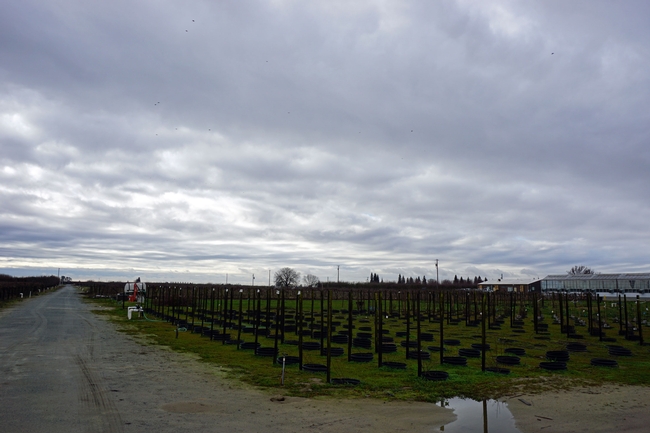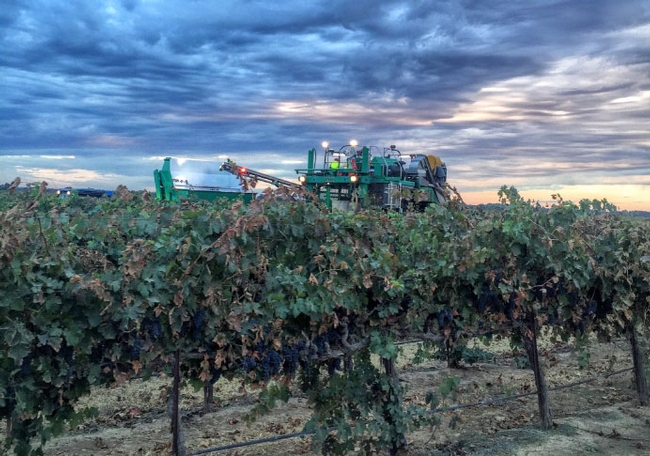Posts Tagged: drought
Monthly news round up: February 2018
Scientists' Newest Tool To Fight Agricultural Toxin: A Video Game
(KVPR) Kerry Klein, Feb. 28
It wasn't long after the invention of the internet that scientists discovered the potential for using computing power as a citizen science tool. One of the earliest examples was a computer program developed in the 1990s that allowed users to search for life on other planets. Now a new collaboration takes aim at something a little closer to home: An intersection between citizen science, health, and agriculture, with implications right here in the San Joaquin Valley.
…Aflatoxin is the most potent natural carcinogen known. It's caused by a fungus that can grow in crops like pistachios, peanuts and cotton. A single outbreak in corn in Kenya killed 125 people in 2004, while long-term exposure is responsible for tens of thousands of liver cancer diagnoses each year.
That's why Themis Michailides is grinding up pistachios to test for aflatoxin. He's studied plant diseases for almost 30 years with the University of California Research Extension in Parlier. “My emphasis is how we can manage it, how can we reduce it so that these crops are free from aflatoxin,” he says.
http://kvpr.org/post/scientists-newest-tool-fight-agricultural-toxin-video-game
New study — Climate change threatens major crops in California
(Digital Journal) Karen Graham, Feb. 28
Over the last 10-years, farmers in California have experienced the symptoms of climate change — less winter chill, crops blooming earlier, more heat waves and years of drought when the state baked in record temperatures.
… The study, led by researchers from the University of California Merced and Davis also leaves us with a dire prediction — the increased rate and scale of climate change is “beyond the realm of experience” for the agricultural community, and unless farmers take urgent measures, the consequences could threaten national food security.
…By the end of this century, over 90 percent of the Central Valley will be unsuitable for agriculture. “One under-appreciated aspect of California's climate is how important our temperature envelope is to California's agricultural sector. The right temperatures at the right times are absolutely crucial,” said Faith Kearns, a scientist with the California Institute for Water Resources who was part of the team.
Climate change could decimate California's major crops, and that should concern everyone
(Think Progress) Natasha Geiling, Feb. 28
A new study, published on Tuesday in the journal Agronomy, contains a dire warning for anyone in the United States who eats: By the end of the century, climate change could wreak havoc on California's major crops, prompting a sharp downturn in the state's ability to produce things like almonds, wheat, and corn.
… The study, led by researchers from University of California Merced and Davis, looked at both past trends and potential future impacts of climate change on temperature, snowpack, and extreme events like drought, heatwaves, and flooding. Researchers then looked at how those projected changes would impact some of California's most important crops, including fruits and nuts.
https://thinkprogress.org/climate-change-california-crops-decline-study-d1cef69f0520/
Researchers Say Climate Change Could Significantly Reduce Crop Yields By 2050
(Capital Public Radio) Ezra Romero, Feb. 27
Climate change could decrease the yield of some crops in the state by up to 40 percent by 2050. That's a big deal for farmers growing more than 400 commodities.
Tapan Pathak, a UC Cooperative Extension specialist based in Merced, and his research team analyzed more than 90 studies on climate change and discovered that warming temperatures may alter where crops grow across California. Their findings were published in Agronomy Journal.
“In order to make California agriculture more sustainable we have to act now,” Pathak said.
California agriculture faces serious threats from climate change, study finds
(Desert Sun) Ian James, Feb. 27
Over the past decade, California farmers have been seeing symptoms of climate change in their fields and orchards: less winter chill, crops blooming earlier, more heat waves and years of drought when the state baked in record temperatures.
Scientists say California agriculture will face much bigger and more severe impacts due to climate change in the coming decades. In a new study, University of California researchers said those effects range from lower crop yields to warming that will render parts of the state unsuitable for the crops that are grown there today.
…“One under-appreciated aspect of California's climate is how important our temperature envelope is to California's agricultural sector. The right temperatures at the right times are absolutely crucial,” said Faith Kearns, a scientist with the California Institute for Water Resources who was part of the team. “For example, warm weather in January and February can reduce almond yields, but warm summers can reduce peach yields. So, there really is no-one-size-fits-all adaptation approach.”
Study: Climate Change Threatens Major Crops in California
(KQED) Amel Ahmad, Feb. 27
California currently provides two-thirds of the country's fruits and nuts, but according to a new study published Tuesday, by the end of the century California's climate will no longer be able to support the state's major crops, including orchards.
…The study, led by researchers from the University of California, Merced and Davis campuses, looked at past and current trends in California's climate and examined what impact record low levels of snowpack, and extreme events such as drought will have on crop yields over time.
https://ww2.kqed.org/science/2018/02/27/study-climate-change-will-wipe-out-major-crops-in-california/
Report: Climate Change Could Ruin California's Farming Industry
(Courthouse News Service) Nick Cahill, Feb. 27
In a study released Monday, University of California researchers predict major damage to many of California's over 400 different crops due to climate change, and outline ways for the state and farmers to brace for future climate challenges.
…Peter Gleick, founder of the Pacific Institute and one the country's foremost water experts, applauded the study sponsored by the University of California Office of the President.
“This may be the most important article on this subject I've ever seen, and I've seen them all,” Gleick tweeted.
https://www.courthousenews.com/report-climate-change-could-ruin-californias-farming-industry/
Grain Diseases Must Be Closely Monitored
(California Ag Today) Patrick Cavanaugh, Feb. 27
Mark Lundy is a UC Cooperative Extension Specialist in grain cropping systems at UC Davis. Lundy runs trials on grain crops because California is such a diverse environment and there are different conditions from year to year so it's important to be consistent in measuring yield and crop quality, grain diseases, and agronomic traits on small grains.
Lundy's work is predominantly on California wheat, but there are many trials on barley.
“Improved varieties have been the mainstay of my work,” Lundy said. “I came at it from a water and nitrogen management background, and one of our goals is trying to disentangle the environment that you can't control from the environment that you can control. But this is the second year where we have some of those gradients in there so we are trying to maintain the attributes we have, while also trying to add some value."
https://californiaagtoday.com/grain-diseases-must-closely-monitored/
Free healthy living workshops at the Placerville Library
Mountain Democrat, Feb. 27
The Placerville Library is teaming up with the University of California Cooperative Extension's UC CalFresh Nutrition Education Program to offer free workshops promoting health and reducing risk for obesity and major chronic diseases. Visit the library for these hands-on “Eat Healthy Be Active” classes with free cooking demonstrations Fridays in March from 2-3 p.m. at the Placerville Library, 345 Fair Lane.
https://www.mtdemocrat.com/prospecting/free-healthy-living-workshops-at-the-placerville-library/
Green thumbs not required (UC Master Gardeners on the cover of magazine)
(Central Valley Magazine) Cyndee Fontana-Ott
…Locally there are plenty of resources for the budding home gardener. One of the most valuable is the UCCE Master Gardeners of Fresno County.
Master Gardeners are specially trained and certified and also must meet requirements for volunteer hours and continuing education.
https://issuu.com/fresnobee/docs/cvmarchlpd
Website helps California poultry producers monitor avian flu risk
(Feedstuffs) UCANR news release, Feb 23
To reduce potential exposure to avian influenza, a new interactive website is now available to help California poultry producers, backyard poultry enthusiasts, regulators and risk managers assess the locations of waterfowl relative to poultry farms in the Central Valley, according to the University of California (UC) Division of Agriculture & Natural Resources.
http://www.feedstuffs.com/news/website-helps-california-poultry-producers-monitor-avian-flu-risk
Trump 'gets what you're saying': Agriculture secretary talks immigration, water and food stamps on California tour
(LA Times) Geoff Mohan, Feb. 21
"You might already know this …," Central Valley farmer Sarah Woolf offered politely, before launching on a primer on California's convoluted water system.
"No, I don't," Sonny Perdue, Trump's secretary of Agriculture, interrupted. "I need all the education I can get."
…Perdue also is a successful businessman who built a commodities trading company one grain elevator at a time.
Those are traits Trump respects in Perdue, which could give him unusual power in the Cabinet, said Dan Sumner, an agriculture and resource economist at UC Davis.
"When he says things to Trump, Trump can hear him saying, 'Be careful about your constituency. Unless you want to see Nancy Pelosi in power, you better see to the reelections in the Central Valley.' "
Put more bluntly, Trump has to ponder whether he wants Republican Congressman Devin Nunes or some Democrat leading the Russia investigation, Sumner said.
http://www.latimes.com/business/la-fi-perdue-california-20180221-story.html
How the federal government can get biotech regulation right
(Des Moines Register) Opinion Alison Van Eenennaam and Nina Fedoroff, Feb. 20
In his speech at the recent American Farm Bureau convention, President Trump said his administration was "streamlining regulations that have blocked cutting-edge biotechnology.”
Why is this necessary? Paraphrasing New York Times columnist Paul Krugman's words on economic policy, it's because we're still living with “zombie” biotech regulatory policies that “should have been killed by the evidence … but keep shambling along nonetheless.” The time to end this “reign of error” is now.
Why now? Because the evidence is in: Biotechnology methods are safe. And because new, precise gene-editing approaches are poised to revolutionize agriculture. But for that to happen, we have to start regulating from common sense instead of fear.
California Coffee Industry Gaining Ground
(Ag Net West) Feb. 20, 2018
The California coffee industry is steadily expanding as demand for the domestically grown product shows significant promise. Last year, Frinj Coffee cooperative sold their entire crop to Blue Bottle Coffee who paid $60 per pound for the beans. Cups of the coffee cost $18 each, and sold out in less than two weeks in the cafes it was being offered in.
Most American coffee production has historically taken place in Hawaii. Farmers in California have started taking interest in producing high-value coffee beans after realizing the sub-tropical plants have the potential to thrive in the state. According to the University of California's Division of Agriculture and Natural Resources, there are currently 30 farms with over 30,000 coffee trees planted. There are also more than 24 farms forecasted to start growing coffee in 2018.
http://agnetwest.com/california-coffee-industry-gaining-ground/
Eureka! California-Grown Coffee Is Becoming The State's Next Gold Mine
(NPR The Salt) Jodi Helmer, Feb. 16
When Mark Gaskell moved to California after working in coffee-growing regions in Central America, he noticed coffee plants growing in gardens and wondered if large-scale production was an option.
In 2001, Gaskell, farm advisor for the University of California Cooperative Extension, established transplants and discovered that the sub-tropical plants could thrive in the Golden State. He recruited Jay Ruskey of Good Land Organics to help with trials, hoping coffee could be a valuable niche crop to help sustain small farms.
…Local farmers embraced the idea of California coffee and started planting their own crops. The burgeoning state industry now boasts 30 farms growing more than 30,000 coffee trees, according to the University of California's Division of Agriculture and Natural Resources.
At least two dozen more farms are expected to begin growing coffee in 2018.
Although coffee farms are scattered throughout California, the biggest concentrations are in Santa Barbara and San Diego counties. Most of the farms are fewer than five years old and their beans are just starting to mature. As that happens, Gaskell expects production to double year over year.
"The California coffee industry is growing very quickly," he says.
Lab-Grown Meat Is Coming, Whether You Like It or Not
(Wired) Matt Simon, Feb. 16
Clean meat companies claim the process will be more efficient because you're only growing the bits you need to feed people—no guts or eyeballs or brains. And without the need for massive livestock operations, you could theoretically spread out your manufacturing facilities, cutting down on transportation emissions. But few studies have looked rigorously at the environmental pros and cons of in vitro meat production.
What scientists really need is something called a life cycle analysis. It would tabulate all the things that go into making food, like water, land, and greenhouse gas emissions. “It's very easy to say, for example, ‘Well I don't know, in vitro doesn't use as much land as beef cattle production,'” says Alison Van Eenennaam, an animal geneticist at the University of California, Davis. “OK, but that's just one component of a life cycle analysis.”
https://www.wired.com/story/lab-grown-meat/
When to spray fruit trees? It depends
(Sac Bee) Debbie Arrington, Feb. 16
Q: I had a helluva time with thrips in 2017, but I also did not know what they were at the time and did not spray for them either – other than my typical two- to three-time dormant spray with copper and horticultural oil. I live in San Jose and have around 35 fruit trees in my backyard orchard: cherries, peaches, apricots, pluots, apples, pears, guavas, pomegranates and citrus. I covered my backyard with weed fabric last year and it has a 3- to 4-inch layer of mulch, so virtually all of the weeds have been kept at bay (knock on wood). I can already see that several peach trees have swollen buds and bloom should start in a week or less.
“Thrips usually aren't a big problem except for nectarines, on which they cause russetting,” said Chuck Ingels, farm adviser for the UC Cooperative Extension in Sacramento County.
http://www.sacbee.com/entertainment/living/home-garden/garden-detective/article200554394.html
Rhodes grass: Forage option in California's low desert?
(Western Farm Press) Cary Blake, Feb 15
After two-and-a-half years of a University of California experimental forage field trial in the state's southernmost county, Imperial, initial trial results suggests that Rhodes grass (Rhodes gayana) could be a solid new perennial forage crop for low desert growers.
“In the trial, Rhodes grass has been highly adaptable, easy to establish, highly drought tolerant, no pest and disease issues so far, and produced large amounts of biomass with high nutrient value as a hay for livestock feed,” said Dr. Oli Bachie, director, UC Cooperative Extension (UCCE) Imperial County at Holtville.
http://www.westernfarmpress.com/cover-crops/rhodes-grass-forage-option-california-s-low-desert
Sec. Sonny Perdue visits World Ag Expo
(Hanford Sentinel) Chelsea Shannon, Feb. 14
Another issue was raised by Glenda Humiston, vice president of Agriculture & Natural Resources at the University of California Office of the President.
She said the current definition of rural prevents enough funding to go toward agriculture research in California. Humiston said rural counties have no cities with populations greater than 50,000, disqualifying many counties.
“If a county has one town that has 50,000 population in it, the entire county is labeled metropolitan for purposes of allocating funding,” Humiston said.
Perdue said that there is work being done to fix the definition of rural amongst different departments in the government.
World Ag Expo: Secretary Perdue takes pulse of agriculture community
(Porterville Recorder) By Matthew Sarr, Feb. 14
United States Secretary of Agriculture Sonny Perdue was in attendance at the International Agri-Center to participate in a town hall meeting, where he offered his thoughts on California agriculture and attendees expressed their concerns and questions.
…A representative from the UC Cooperative Extension expressed the importance of federal funding for agricultural research, as well a need to make better distinctions between rural and metropolitan counties for the purposes of allocating those dollars, which drew a round of applause from the audience.
Sonny Perdue hears from California growers at World Ag Expo
(Western Farm Press) Todd Fitchett, Feb. 14
While trade, labor and regulatory issues may top the list of agricultural policy issues Perdue faces in Washington D.C., Glenda Humiston, Vice President of the University of California Agriculture and Natural Resources Division of the state's Land Grant university, stressed the importance of adequate research funding and federal definitions of rural versus urban, which she said is having detrimental impacts across California on important program funding.
Humiston said that while UCANR has a “proud tradition of research in California,” the university is plagued by reduced budgets at the same time the state is plagued by a new invasive pest every several weeks. She said for the university to stay ahead of these issues and to help growers in these and many other areas, additional funding is vital.
The United States is losing the battle over agricultural research with China, which spends more in that sector, Humiston says. She continues to trumpet the idea of greater broadband access to rural areas of the state as new agriculture will demand internet upgrades for technology like sensors and driverless spray rigs.”
http://www.westernfarmpress.com/usda/sonny-perdue-hears-california-growers-world-ag-expo
It's weather, not climate change, Governor Brown
(Canada Free Press) Robert W. Endlich, Feb. 14
2017 featured incredibly intense, damaging wildfires in California: first the Wine Country fires of October, and later the massive Thomas Fire in December. Each destroyed hundreds of homes, the latter in many of the affluent suburbs and enclaves northwest of Los Angeles and Hollywood.
The Thomas Fire is the largest in modern California history, with over 1000 structures destroyed. The fires and subsequent mudslides killed over 60 people and left many others severely burned or injured.
… This is exactly the situation described in a recent article that mentions October as the worst month for wildfires and quotes University of California fire expert Max Moritz, who says “By the time you get to this season, right when you're starting to anticipate some rain, it's actually the most fire prone part of the year.” Power line and other management failures increase the likelihood of disaster.
https://canadafreepress.com/article/its-weather-not-climate-change-governor-brown
The East Bay's Future Climate Will Be Both Dry and Wet
(East Bay Express) Robert Gammon, Feb. 14
Typically, we think of dry and wet climates as being distinct. But the East Bay of the future may experience devastating aspects of both.
Many climate scientists expect California to increasingly experience intense periods of drought this century, much like the bone-dry winters from 2011 through 2015. Researchers also predict that Mediterranean climates — like that of the Bay Area — will become drier overall as global temperatures rise.
…"By 2050, it's clearly going to be drier and warmer," said Bill Stewart, a forestry specialist at UC Berkeley's Department of Environmental, Science and Policy Management. Stewart said that during the coming decades, the East Bay's landscape is expected to add more shrubland and lose forest, shifting "to vegetation that does better in drier terrain."
Lodi Honors Longtime Farm Advisor
(Wines & Vines) Ted Rieger, Feb. 13
Lodi Grape Day has long been one of the region's most informative and well attended educational meetings for grape growers. At the 66th annual Grape Day held Feb. 6, Lodi's grape and wine industry honored the man who helped organize the educational sessions for nearly half the Grape Days held to date. Paul Verdegaal, University of California Cooperative Extension (UCCE) San Joaquin County farm advisor for the past 31 years, officially retired Jan. 1. His longtime service was recognized as this year's Grape Day keynote speaker.
https://www.winesandvines.com/news/article/195690/Lodi-Honors-Longtime-Farm-Advisor
2018's Healthiest & Unhealthiest Cities in America
(Wallet Hub) Richie Bernardo, Feb. 12
What are the most important factors to consider in choosing a city that is good for your health?
Lorrene Ritchie:
Location, of course, matters. But it is important to think about not just the city, but the neighborhood – both near your home and your work (to the extent one has control over this), as these are the locations most people spend most of their time. And it is important to know what would help you make healthy choices, as this can differ between individuals. For example, a nearby tennis court is only helpful if you like to play tennis. A farmers' market nearby only works if that's the sort of market you would shop at.
https://wallethub.com/edu/healthiest-cities/31072/#lorrene-ritchie
Flash bloom: Warm weather has all almond varieties blooming at the same time
(Chico Enterprise-Record) Steve Schoonover, Feb. 9
The warm weather we've been enjoying has produced what's called a “flash bloom” in almonds, with all the varieties blooming at once.
…The idea is to get what Butte County UC Cooperative Extension Farm Advisor Luke Milliron called “bloom overlap.”
…Glenn County Farm Advisor Dani Lightle said the weather has been good for bee flight, with warm temperatures and little wind.
“But with the crush of flowers all at the same time, can they get to them all?” she asked.
http://www.chicoer.com/article/NA/20180209/NEWS/180209724
Farmers Can Put Themselves On The Map If They Complete The U.S. Agriculture Census By February 5
(Capital Public Radio) Julia Mitric, Feb. 5
…The once-every-five-year census also paints a picture that can help the University of California Division of Agriculture and Natural Resources, which leads beginning farmer and rancher training programs.
Jennifer Sowerwine works on these programs through the UC Cooperative Extension at UC Berkeley.
"The Ag Census data is helpful in my work because we can see changes over time in the demographic profile of farmers [race, gender and size] that can help inform the type of training we offer," explains Sowerwine.
'Never ending' drought news from UC ANR
Warm and sunny winter days are no cause for celebration among the farmers, ranchers and forest managers who rely on UC Agriculture and Natural Resources' research-based information and expertise to make their work more profitable. Such is the feeling shared by UC Cooperative Extension advisor Dan Macon in his Foothill Agrarian blog. He began worrying more than a month ago about the spate of dry weather in the state.
"While I'm a worrier by nature, I think worrying about the weather is natural for anyone who relies on Mother Nature directly," Macon wrote.
The UC Food Observer blog warmly praised the quality of Macon's blog in a post titled The NeverEnding (#drought) story.
"He knows his subject and he writes well about it. I read every post, but his most recent piece about Old Man Reno, one of his farm dogs, really resonated with me. Read his blog every chance you get: it will make you feel better about life," wrote Rose Hayden-Smith, the author of the UC Food Observer.
The column included a shout-out about the recent launch of a three-video series on the drought produced by UC ANR's California Institute for Water Resources (CIWR). The series opens with Cannon Michael of Bowles Farming in Los Banos. The alfalfa grower works with UCCE specialist Dan Putnam.
“There's a lot of misunderstanding about alfalfa as a crop,” Michael said. “It does take water to grow it, as with anything, but you get multiple harvests of it every year.”
Videos two and three will be launched March 2 and April 6.
The UC Food Observer also recommended a blog produced by the CIWR's Faith Kearns – The Confluence. She recently wrote about how California's idea of “natural” beauty may have shifted during the drought.
Rain and snow bring hope to California farmers
California's years-long drought is easing up, with storms delivering rain and snow that has exceeded "normal" for the state, reported Jed Kim for the Marketplace Sustainability Desk. Kim interviewed Dan Sumner, the director of the UC Agricultural Issues Center, a UC Agriculture and Natural Resources statewide program that focuses on such topics such international markets, invasive pests and diseases, and rural development.
Sumner shared a message of hope during the two-minute Marketplace clip.
"So far at least, things are close enough to normal that farmers aren't going to make drastic changes in either their planting decisions or their irrigation decisions," Sumner said.
The abundant rainfall this year will ease pressure on the state's groundwater reservoirs, which have been tapped extensively during the drought to keep crops alive when surface water was unavailable.
"What that does is give us a little cushion in terms of planning for long-term changes," Sumner said.
Kim said the state may need to plan for a future with more limited water resources, "a future that may come sooner rather than later."
California may be emerging from the grip of drought
The California rainy season is off to a good start, raising hopes that the ongoing drought will be snapped, reported Aaron Davis in the East Bay Times.
"We've seen a sigh of relief from a lot of growers that are right at about half of their total seasonal average and we are halfway through the season," said Paul Verdegaal, UC Cooperative Extension viticulture advisor in San Joaquin County.
The rain is helping flush salts away from the grapevines' rootzones and refill the aquifer, which has been depleted in some areas due to the years-long drought.
The National Weather Service's Seasonal Drought Outlook shows areas of Northern California already free from drought, some areas where the drought designation remains, but is improved, and areas where drought designation removal is "likely."
Half of the state's annual rainfall comes in December, January and February. "This is only mid-December .... So we still have a ways to go in our wet season and Northern California is well above average," said Jeanine Jones, deputy drought manager with the California State Department of Water Resources.
California's native fish in steady decline for 50 years
California's fresh water fish are in trouble, and not just because of the drought, reported Lori Pottinger in the Viewpoints blog published by the Public Policy Institute of California.
Pottinger asked Ted Grantham, UC Cooperative Extension specialist in the Department of Environmental Science Policy and Management at UC Berkeley, whether the state's fish are adapted to periodic droughts.
Drought is one stressor, he said, but there are additional factors imperiling fish.
"California's native fish have been in steady decline for at least 50 years — in part due to dams, habitat degradation, and the introduction of non-native species," Grantham said. "Native fishes have developed several strategies to cope, but key to their long-term survival is their ability to recover from drought during wet years."
Grantham said there are at least three strategies that would help better manage the state's native fish.
- Better define the amount of water needed to sustain healthy fish populations.
- Create an accurate accounting system for tracking water availability and use.
- Recognize that not all streams are created equal. Some streams support more biological diversity.
The ecosystems science researcher said he is optimistic about the future.
"Although the drought has severely affected California's freshwater ecosystems, it also has raised awareness about the need to improve water management and better prepare for climate change," he said.
For more on threats to California native fish, read Identifying gaps in protecting California's native fish in the UC California Institute for Water Resources' blog The Confluence.






